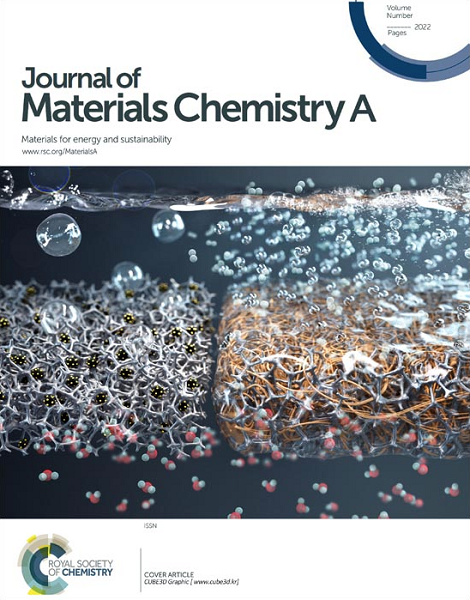Beyond Traditional TOF: Unveiling the Pitfalls in Electrocatalytic Active Site Determination
IF 9.5
2区 材料科学
Q1 CHEMISTRY, PHYSICAL
引用次数: 0
Abstract
Turnover frequency (TOF) is a fundamental metric for evaluating the intrinsic activity of an electrocatalysts for water splitting. Moreover, being associated with free energy changes of the overall process (according Arrhenius formula) the TOF serves as a significant metrics that deals with molecular origin of electrocatalytic activity compared to conventional current density or overpotential as the standard descriptors. For instance, current density signifies the overall rate of an electrochemical reaction, however, it is influenced by the number of electrochemical active sites (ECASs). Which making it hard to distinguish whether the catalytic activity is due to the quality of active sites or due greater number of reactive centres. TOF, on the other hand, defines per site activity shedding light on the real efficiency of the individual active sites. While catalyst with larger ECAS may exhibit higher current densities, their TOF can be significantly lower due to less efficient active sites. This showcases the importance of optimizing not just the quantity, but the quality and electronic environment of active sites to achieve efficient electrocatalysis. Further detail kinetic analysis, considering multi-step electrocatalytic process reveals that the rate constant or TOF is mainly govern by the rate-determining step (RDS) of the catalytic cycle and the nature of the active site involved. Conventional electrochemical and non-electrochemical ways of determining electrochemical active site (ECAS) for an electrocatalyst are facing a serious limitation as the calculated TOF value from this does not reflect its intrinsic nature. ECAS determination via various electrochemical methods suffers from a strong dependence on the catalyst loading, scan rate, and substrate selected for electrochemical analysis. Direct measurement of ECAS via ICP-MS, and structural characterization may lead to overestimation by assuming 100% atom utilization. Moreover, none of the reported procedure consider the importance of RDS in the catalytic cycle. Using theoretical analysis, in-situ spectroscopic technique and various electrochemical analyses have proven effective in identifying the nature of RDS and active sites involved. Therefore, integrating such advance measurement along with standard electro/non-electrochemical technique can provide a more accurate picture of TOF which certainly would help to developed effective electrocatalyst for sustainable hydrogen production in future.超越传统TOF:揭示电催化活性位点测定的陷阱
转换频率(TOF)是评价水裂解电催化剂本征活性的基本指标。此外,TOF与整个过程的自由能变化(根据Arrhenius公式)相关联,与传统的电流密度或过电位作为标准描述符相比,它是处理电催化活性分子起源的重要指标。例如,电流密度表示电化学反应的总速率,然而,它受到电化学活性位点(ECASs)数量的影响。这使得很难区分催化活性是由于活性位点的质量还是由于更多的反应中心。另一方面,TOF定义了每个站点的活动,从而揭示了单个活性站点的实际效率。虽然具有较大ECAS的催化剂可能具有更高的电流密度,但由于活性位点效率较低,其TOF可能显着降低。这表明了优化活性位点的数量、质量和电子环境以实现高效电催化的重要性。进一步详细的动力学分析表明,考虑到多步电催化过程,TOF的速率常数主要由催化循环的速率决定步骤(RDS)和所涉及的活性位点的性质决定。传统的电化学和非电化学方法确定电催化剂的电化学活性位点(ECAS)面临着严重的局限性,因为由此计算的TOF值不能反映其内在性质。通过各种电化学方法测定ECAS受到催化剂负载、扫描速率和电化学分析所选择的底物的强烈依赖。通过ICP-MS直接测量ECAS和结构表征可能会导致假设100%原子利用率的高估。此外,所有报道的程序都没有考虑到RDS在催化循环中的重要性。通过理论分析、原位光谱技术和各种电化学分析,已经证明可以有效地识别RDS的性质和所涉及的活性位点。因此,将这种先进的测量方法与标准的电/非电化学技术相结合,可以提供更准确的TOF图像,这必将有助于开发有效的电催化剂,用于未来的可持续制氢。
本文章由计算机程序翻译,如有差异,请以英文原文为准。
求助全文
约1分钟内获得全文
求助全文
来源期刊

Journal of Materials Chemistry A
CHEMISTRY, PHYSICAL-ENERGY & FUELS
CiteScore
19.50
自引率
5.00%
发文量
1892
审稿时长
1.5 months
期刊介绍:
The Journal of Materials Chemistry A, B & C covers a wide range of high-quality studies in the field of materials chemistry, with each section focusing on specific applications of the materials studied. Journal of Materials Chemistry A emphasizes applications in energy and sustainability, including topics such as artificial photosynthesis, batteries, and fuel cells. Journal of Materials Chemistry B focuses on applications in biology and medicine, while Journal of Materials Chemistry C covers applications in optical, magnetic, and electronic devices. Example topic areas within the scope of Journal of Materials Chemistry A include catalysis, green/sustainable materials, sensors, and water treatment, among others.
 求助内容:
求助内容: 应助结果提醒方式:
应助结果提醒方式:


